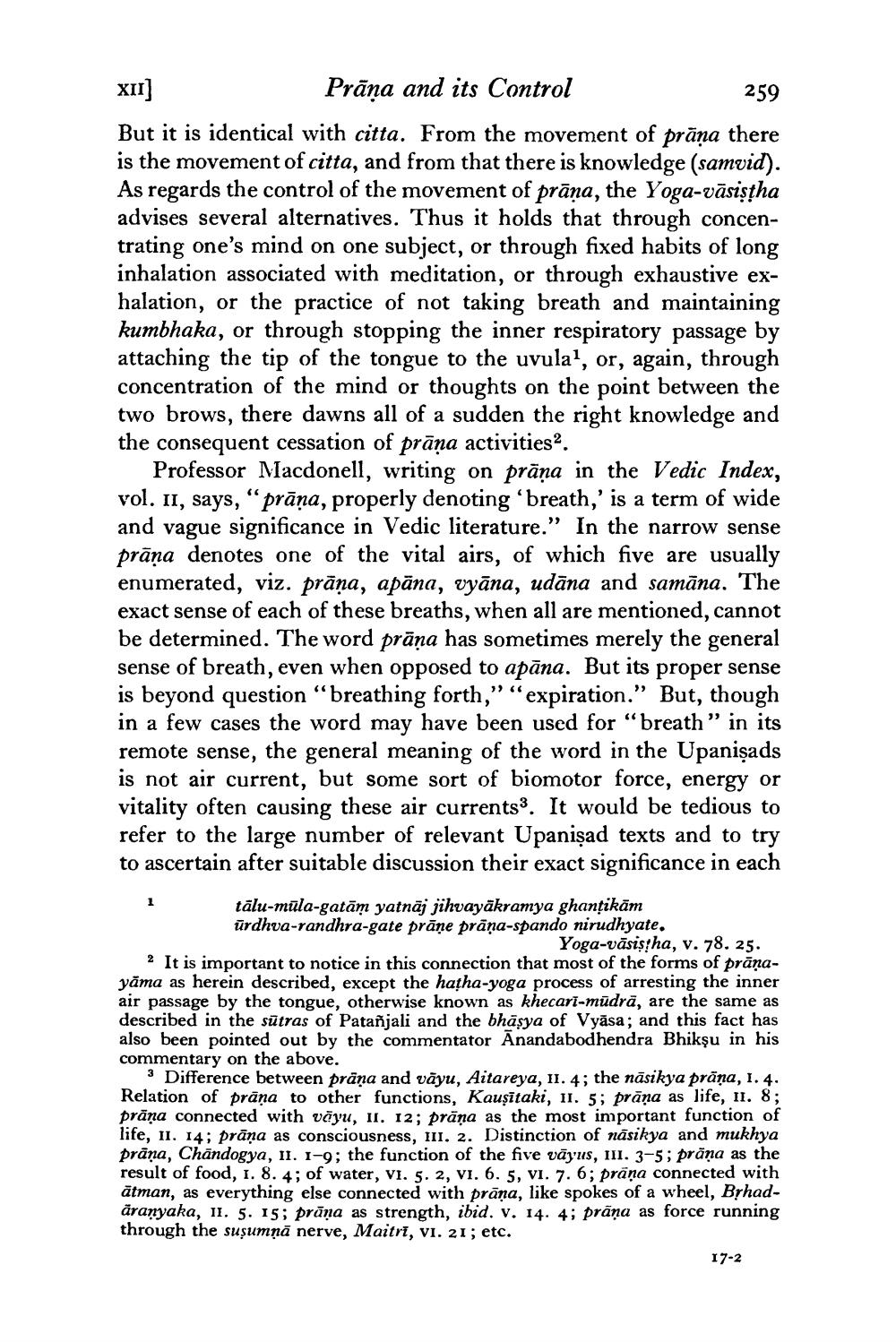________________
XII] Prāņa and its Control
259 But it is identical with citta. From the movement of prāna there is the movement of citta, and from that there is knowledge (samvid). As regards the control of the movement of prāna, the Yoga-vāsiştha advises several alternatives. Thus it holds that through concentrating one's mind on one subject, or through fixed habits of long inhalation associated with meditation, or through exhaustive exhalation, or the practice of not taking breath and maintaining kumbhaka, or through stopping the inner respiratory passage by attaching the tip of the tongue to the uvula?, or, again, through concentration of the mind or thoughts on the point between the two brows, there dawns all of a sudden the right knowledge and the consequent cessation of prāna activities.
Professor Macdonell, writing on prāņa in the Vedic Index, vol. 11, says, "prāņa, properly denoting 'breath,' is a term of wide and vague significance in Vedic literature.” In the narrow sense prāņa denotes one of the vital airs, of which five are usually enumerated, viz. prāna, apāna, vyāna, udāna and samāna. The exact sense of each of these breaths, when all are mentioned, cannot be determined. The word prāņa has sometimes merely the general sense of breath, even when opposed to apāna. But its proper sense is beyond question “breathing forth," "expiration." But, though in a few cases the word may have been used for “breath” in its remote sense, the general meaning of the word in the Upanişads is not air current, but some sort of biomotor force, energy or vitality often causing these air currents. It would be tedious to refer to the large number of relevant Upanişad texts and to try to ascertain after suitable discussion their exact significance in each
tālu-müla-gatām yatnāj jihvayäkramya ghanţikām ürdhva-randhra-gate prāne prāņa-spando nirudhyate.
Yoga-vāsisha, v. 78. 25. 2 It is important to notice in this connection that most of the forms of prānayāma as herein described, except the hatha-yoga process of arresting the inner air passage by the tongue, otherwise known as khecari-mūdrā, are the same as described in the sūtras of Patanjali and the bhāsya of Vyāsa; and this fact has also been pointed out by the commentator Anandabodhendra Bhikşu in his commentary on the above.
3 Difference between prāna and vāyu, Aitareya, 11. 4; the nāsikya prāņa, 1. 4. Relation of prāna to other functions, Kausitaki, 11. 5; prāņa as life, II. 8; prāņa connected with vāyu, II. 12; prāna as the most important function of life, II. 14; prāņa as consciousness, III. 2. Distinction of nāsikya and mukhya prāna, Chandogya, 11. 1-9; the function of the five vājus, III. 3-5; prāņa as the result of food, 1. 8. 4; of water, vi. 5. 2, VI. 6. 5, VI. 7. 6; prāņa connected with ātman, as everything else connected with prāna, like spokes of a wheel, Brhadaranyaka, il, 5. 15; prāna as strength, ibid. v. 14. 4; prāņa as force running through the suşumņā nerve, Maitri, vi. 21; etc.
17-2




